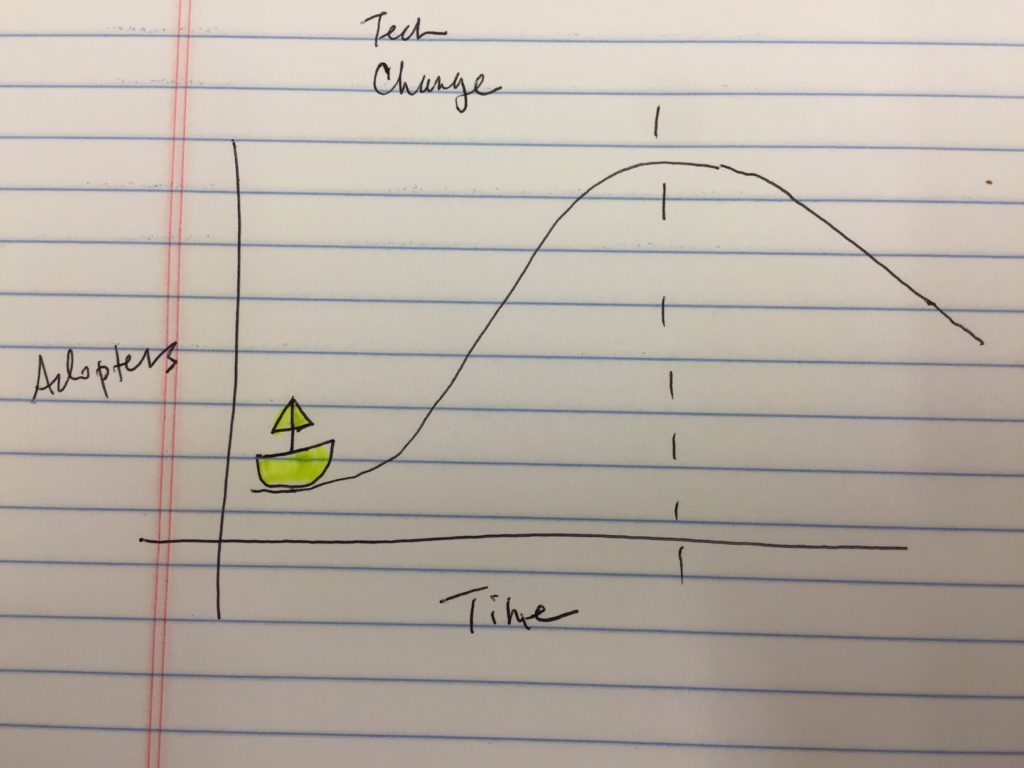This is another post in the series about MyYearinIT.
Not too long ago I found myself in a “Strategic IT” meeting we were discussing where we each sit on the curve of change. The discussion leader drew something a bit like this on his whiteboard and asked us each to come up and put a mark where we would be in the curve of adopting to technological changes.
He then asked: Were we on the leading edge? Or did we follow the crowd?
Various colleagues got up and put a mark somewhere on the curve, most of them right around the big bump (those who tended to jump on the bandwagon with everyone else) and a few afterwards (those folks said that they usually waited to whether a technology was likely to last before they adopted it). I was one of the last people to go up to the sign and leave my mark.
This is where I put myself (note: I was the only person to draw a picture, but I’m dorky like that):
 I then told the group a story that’s become a touchstone for me…
I then told the group a story that’s become a touchstone for me…
When I first began canoeing on the ocean, it was pretty scary to be surrounded by wide open water. The swell could be a low rolling bump that gave a gentle nudge to the boat or the entire ocean could be flat as a pancake, where you had to dig in your paddle to do all the work. But of course there was also the possibility of really big swell. And the first time I encountered that, it was unforgettable.
I was still a ‘novice’ paddler and had only been out on the ocean a few times. I was out with a coed crew that included both experienced and new paddlers. Once we got our nose out of the harbor and we realized that we were in the middle of big swell, the crests of the waves around us had already completely obscured the harbor that we’d just left.
The natural inclination when you see a big wave coming at your boat is to freeze up and stop paddling. But that’s exactly the wrong thing to do. If you stop paddling you significantly increase the likelihood of a capsized canoe. So I was staring at these great big bumps coming at us. And I was starting to freeze up and panic and even moan a little.
Then Jim, sitting in the seat behind me, spoke up and gave me the advice that was just what I needed to hear at that moment. He reminded me that the only way through this was to face it head on and start paddling. He said this as we watched a wall of water rushing towards the boat.
“We’re committed to this one,” he said, and yelled at me to dig my paddle in.
I am sure I yelled as I followed his direction. The wave came at us and we pointed our nose directly into it. The front of the boat drew up high on top of it the bump and for a second our nose was several feet high in middair. And then just as fast we crashed over on the other side, our huge 400-pound fiberglass boat coming down with a giant thwack as it bellyflopped onto the water below. And just as my stomach was starting to ease from that one, another wall of wave came at us and we did the same.
Dig in deep. Up and over. Crash.
Dig in deep. Up and over. Crash.
Our canoe looked something like this as we came on top of each bump:
It was undoubtedly one of the most exciting experiences of my life up to that point and it cemented my passion for the canoe. There is nothing half-hearted out there. It is all in, all the time. Digging into every bump ahead is the only thing that matters. There’s nothing quite as enlivening as a wave barreling right at your boat and feeling the rush of adrenaline as you take it head-on and paddle through it.
Since then I’ve faced some pretty big swell, and when that happens Jim’s words of wisdom often come to mind, We’re committed to this one.
So back to the technology curve.
I work a lot like I paddle. I like seeing something interesting (perhaps a bit frightening) on the horizon. I like the excitement that comes with not exactly knowing exactly how big or how impactful that thing will be, but facing into it and taking it on. Geolocation? Oh Yah. Wearables? Bring it! Social Media? Dig in Deeper! Mobility? We’re Committed!
This approach is not cautious or measured. It is a hands-on, we’re committed way of working, and it’s the opportunity to face (and perhaps embrace) new technologies that make my job so enjoyable. Trying new things, like ocean canoeing, is fun. Then considering how those new things fit into the landscape of Higher Ed and into the contours of my classroom, is the kind of challenge that makes every day different and more interesting than the day before.

